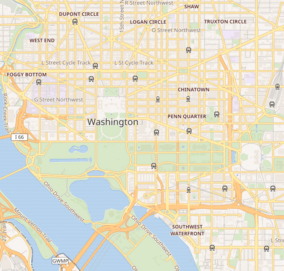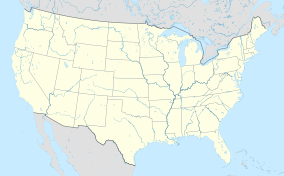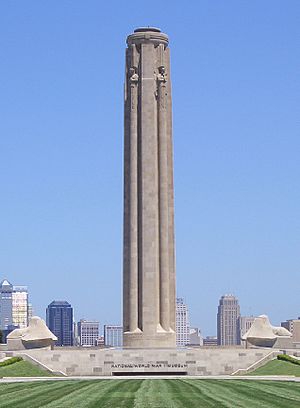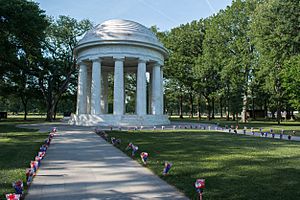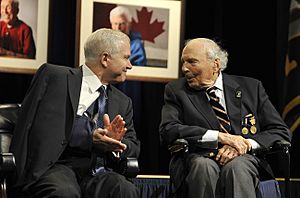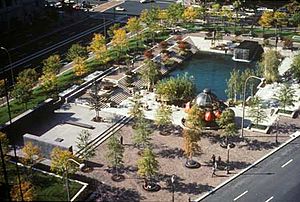National World War I Memorial (Washington, D.C.) facts for kids
Quick facts for kids National World War I Memorial (planned) |
|
|---|---|
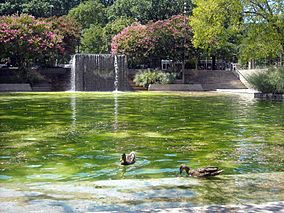
Looking east at the Pershing Park pond and fountain in 2008
|
|
| Location | Washington, D.C., U.S. |
| Nearest city | Washington, D.C. |
| Area | 1.76 acres (7,100 m2) |
| Established | May 14, 1981 (Pershing Park) pending (National World War I Memorial) |
| Governing body | National Park Service and National World War I Memorial Commission |
| Website | National World War I Memorial |
The National World War I Memorial is a special place being built to remember the brave members of the United States Armed Forces who served in World War I. This memorial will be located in Pershing Park in Washington, D.C., at 14th Street and Pennsylvania Avenue NW.
Pershing Park has been around since 1981 and already has a statue honoring John J. Pershing, a very important general from World War I. In 2016, a design called "The Weight of Sacrifice" was chosen for the new memorial. It was created by a team including Joseph Weishaar and Sabin Howard. The memorial is expected to be finished by 2024.
Discovering Pershing Park
Pershing Park is the home of the new National World War I Memorial. It's a green space in the heart of Washington, D.C. Before it became a park, this area had many buildings from the 1800s. These buildings were taken down around 1930.
How Pershing Park Was Created
In 1957, Congress officially named the area Pershing Square. For a long time, people argued about how to best honor General John J. Pershing there. Because of these disagreements, nothing was built, and the square often looked messy. In 1963, city officials finally planted grass and flowers to make it look nicer.
Later, there were big plans to change the whole Pennsylvania Avenue area. These plans would have removed Pershing Square. However, those larger plans were never carried out. Instead, a smaller area called Freedom Plaza was built nearby.
Designs for a statue and a larger park for Pershing were finally approved in the 1970s. Pershing Park was built between 1979 and 1981. It officially opened on May 14, 1981. The American Battle Monuments Commission helped pay for the park.
What You Can See in Pershing Park
Pershing Park features a statue of General Pershing, created by Robert White. Behind the statue, there are memorial walls and benches that tell about Pershing's achievements in World War I. The statue was officially dedicated in 1983.
The park also has a fountain and a pond. In the winter, the pond used to turn into an ice rink for people to enjoy. There are also beautiful flower beds. The government of Washington, D.C., owns Pershing Park. However, the National Park Service manages it as part of the national park system.
The National World War I Memorial
For many years, there wasn't a national memorial in Washington, D.C., specifically for World War I. In 1931, the people of Washington, D.C., built the District of Columbia War Memorial to honor local residents who served. The largest World War I memorial in the country was the Liberty Memorial in Kansas City, Missouri.
The Liberty Memorial is a tall tower with a special burning flame at the top. It opened in 1926. But for over 70 years, no national memorial for World War I was built in Washington, D.C. This made many World War I veterans sad.
Over time, the Liberty Memorial needed repairs. In 1994, its tower was closed. A big renovation project started in 2000, and the memorial reopened in 2002. This project added a lot more space for the museum, a research center, a theater, and storage for its large collection.
The National World War I Museum
As the Liberty Memorial was being fixed up, Senator Kit Bond from Missouri suggested that it should be officially recognized as "America's National World War I Museum." This idea didn't pass at first.
In 2004, as the World War II Memorial was about to open in Washington, D.C., Representative Karen McCarthy from Missouri tried again. She proposed making the Liberty Memorial "America's National World War I Museum." This time, the idea passed both parts of Congress. President George W. Bush signed it into law on October 28, 2004.
Efforts to Create a National World War I Memorial
The idea for a national World War I memorial grew stronger after the successful creation of the World War II Memorial. That memorial was dedicated in 2004. In 2000, Jan Scruggs, who helped create the Vietnam Veterans Memorial, suggested changing the District of Columbia War Memorial to honor all World War I veterans.
In 2008, the American Legion also called for this change. A lawyer named Edwin Fountain started the World War I Memorial Foundation to help raise money and support the effort.
Representative Ted Poe from Texas met Frank Buckles, who was the last surviving American veteran of World War I. Buckles was upset that there was no national memorial for his war. Poe then became a strong supporter of the cause. He introduced a bill called the Frank Buckles World War I Memorial Act. This bill would allow the American Battle Monuments Commission to either take over the D.C. War Memorial or build a new one on the same site.
However, some senators from Missouri were worried that a new memorial would compete with the Liberty Memorial in their state. So, these bills didn't pass at that time.
Creating the World War I Centennial Commission
Finally, in 2012, a compromise was reached. Senator Jay Rockefeller suggested a bill that would do two things:
- Create a World War I Centennial Commission.
- Name both the Liberty Memorial in Kansas City and the District of Columbia War Memorial in Washington, D.C., as National World War I Memorials.
However, many people in Washington, D.C., didn't want their local memorial to be changed. They felt it should stay dedicated only to D.C. residents. Some suggested using Pershing Park for the new national memorial instead, since it already had a statue of General Pershing.
On February 27, 2011, Frank Buckles passed away. His death brought new energy to the effort to create a memorial. Representative Poe introduced his bill again, this time matching Rockefeller's idea to designate both memorials and create the commission.
Opposition to changing the D.C. War Memorial continued to grow. D.C. Delegate Eleanor Holmes Norton and Mayor Vincent C. Gray spoke out against it.
As time ran out, Representative Poe introduced a new bill in 2012. This bill created the World War I Centennial Commission to plan events for the war's 100th anniversary. It also named the Liberty Memorial as the "National World War I Museum and Memorial." Poe agreed to stop trying to change the D.C. War Memorial. Instead, his bill allowed for a new memorial to be built on federal land in D.C. This bill passed Congress and was signed into law by President Barack Obama on January 14, 2013. It only created the United States World War I Centennial Commission.
Creating Two National World War I Memorials
By 2012, officials in D.C. and their supporters in Congress pushed for the new national World War I memorial to be built in Pershing Park. They realized there wasn't enough space on the National Mall for a large new memorial.
In 2014, new bills were introduced by Senator Claire McCaskill and Representative Emanuel Cleaver. These bills named the Liberty Memorial as a "World War I Museum and Memorial." They also allowed for a new World War I Memorial in Washington, D.C., to be built in Pershing Park. These bills made sure the new memorial would not affect the D.C. War Memorial. This plan gained support from Delegate Norton and the World War I Centennial Commission. The new memorial was expected to cost about $10 million and would keep the Pershing statue already in the park.
The World War I Memorial Foundation, however, still wanted the memorial on the National Mall. They felt building it in Pershing Park would make people forget about World War I.
With time running out, the memorial's language was added to a larger defense bill. This bill passed Congress and was signed into law by President Obama on December 19, 2014. This law finally allowed for the creation of a national World War I Memorial in Pershing Park.
Design Competition for the Memorial
On May 20, 2015, the World War I Centennial Commission started a competition to design the new memorial in Washington, D.C. The memorial was expected to cost between $21 million and $25 million. People from anywhere in the world could submit their ideas.
The park's original designer, M. Paul Friedberg, was upset about plans to change or destroy his park. He threatened legal action to protect it. Another expert, Charles Birnbaum, called Pershing Park Friedberg's most important work and started a petition to add the park to the National Register of Historic Places.
A special jury chose five final designs for the memorial on August 19, 2015. These designs were:
- "An American Family Portrait"
- "Heroes Green"
- "Plaza to the Forgotten War"
- "The Weight of Sacrifice"
- "World War One Memorial Concept"
Choosing the Winning Design
In November 2015, the designs were reviewed by the United States Commission of Fine Arts. This group had some concerns about all the designs. They felt the designs didn't value the existing park enough. They suggested thinking of the project as adding a new memorial within the existing park, rather than completely changing it.
In January 2016, the Centennial Commission chose "The Weight of Sacrifice" as the winning design. It was created by Joseph Weishaar, a young architect. The team also included sculptor Sabin Howard, landscape architect Phoebe Lickwar, and GWWO Inc./Architects.
Final Approval and Construction
On July 19, 2018, the Commission of Fine Arts approved a changed design for the memorial. The new design replaced the old fountain with a tall wall featuring sculptures. The sculptor, Sabin Howard, had to revise his design many times before it was approved.
By Veterans Day 2018, the Centennial Commission had raised $20 million of the estimated $40 million cost. They hoped to dedicate the memorial in November 2021. In December 2019, they received the building permit, and work was ready to begin. The first part of the project includes rebuilding the park, adding a peace fountain, and planting trees.
Groundbreaking Ceremony
On November 9, 2017, a special groundbreaking ceremony was held at Pershing Park. Important people like United States Secretary of Veterans Affairs David Shulkin and D.C. Mayor Muriel Bowser attended.
Sabin Howard is creating 38 large bronze figures for a sculpture called A Soldier's Journey. This sculpture tells the story of a soldier leaving family, experiencing war, and returning home. It is expected to be finished in late 2023 or early 2024.


